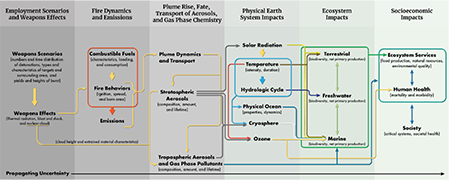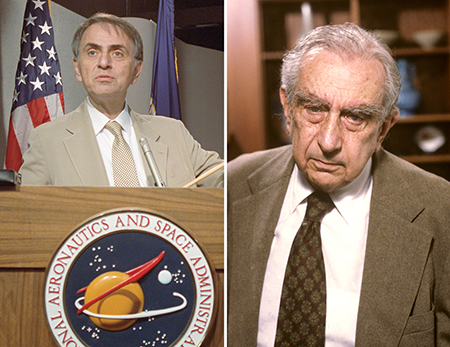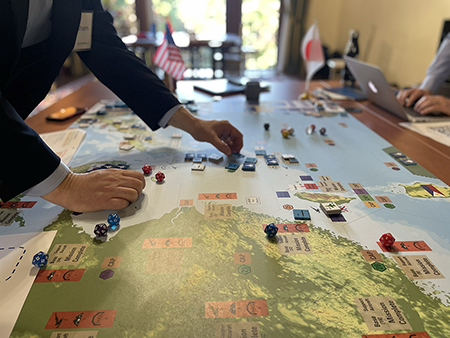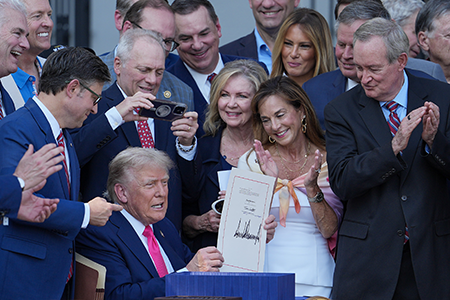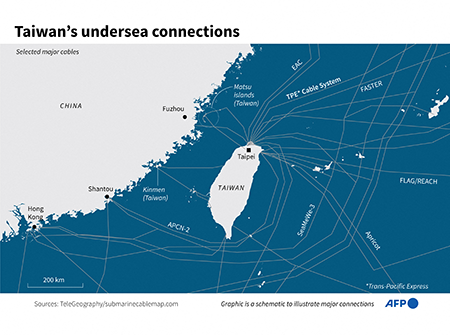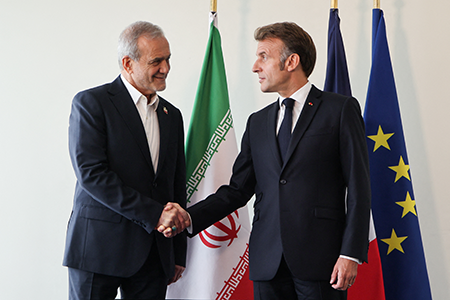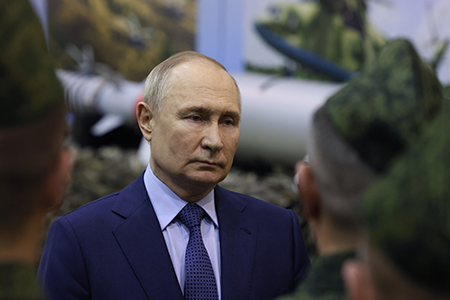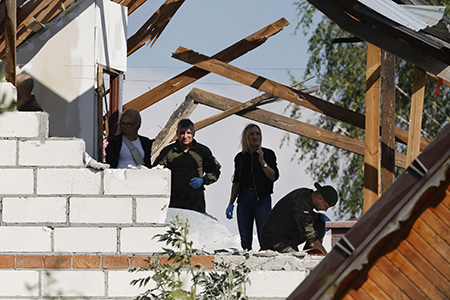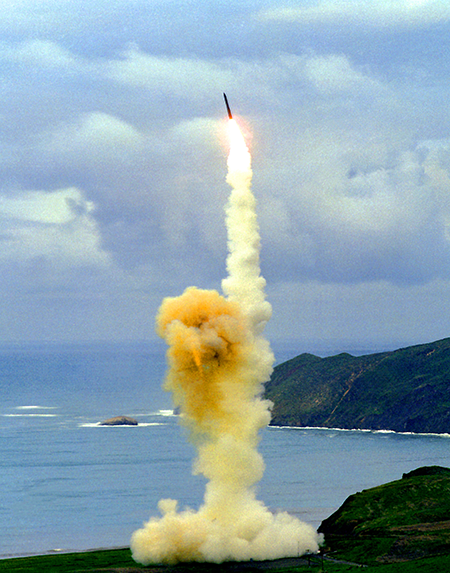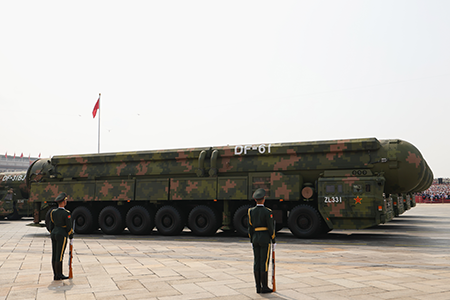2025 Annual Meeting Remarks by Sen. Chris Van Hollen
Senator Van Hollen spoken remarks at the 2025 ACA Annual Meeting.
Arms Control Association Annual Meeting, September 25th, 2025
"Urgent Steps to Address the Nuclear Danger"
Senator Chris Van Hollen (D-Md.)
Well, thank you very much, Tom. Thank you first of all for that introduction. It's wonderful to have you as a constituent. It's always a good idea to have a constituent introduce you as a member of Congress, you never know when they need their road plowed or when they're not.
But seriously, most of all, Tom, I want to thank you for your years of public service, for your leadership here, as chairman of the Arms Control Association. If we can give Tom Countryman a big round of applause.
I also want to thank your entire team. As you said, it may not be large in numbers, but it is large in terms of output and brain power. And I salute your stellar CEO, Daryl Kimball, and the others who are part of this effort. So, thank you all very much.
I have to say it's great to get off of Capitol Hill. It's especially good to be off of Capitol Hill and with you to discuss these very important issues. I should say a brief word about the other issue that is gripping Washington right now, and that is the rising prospect of a government shutdown due to President Trump's demand that he get a blank check from the Congress and his refusal to turn off a ticking time bomb on America's health care at the end of this year, if we don't defuse it, I hope we can work all off that out. We’re here of course today to talk about a different ticking time bomb: the risks of a nuclear conflict and the total devastation that it would bring.
The doomsday clock was established by the Bulletin of Atomic Scientists 78 years ago in the wake of World War II, and it now stands at 89 seconds to midnight, the closest to global catastrophe it has ever been.
For over 50 years, you at the Arms Control Association have worked to prevent that clock from reaching catastrophic nuclear midnight. Indeed, you have been very focused on trying to move the hands of that clock backwards, so that we reduce the risks of nuclear catastrophe. Back in 1983, and I'm dating myself here, I read a New Yorker series, called "The Fate of the Earth" by Jonathan Schell. His article spelled out, in graphic detail, how a nuclear conflagration would be the end of life on Earth as we know it.
It was so alarming that I decided to try to do my part to prevent it. I became very involved in the movement for nuclear arms control in college and in graduate school. From there, I went to work on these issues in the United States Senate, first as a staff member for arms control and defense to former Maryland Senator Charles "Mac" Mathias, who was a major proponent of nuclear arms control, and later as a member of the staff of the Senate Foreign Relations Committee. I’m now a senator on that committee. And while much has changed in those intervening years, one thing remains the same: a global nuclear war would effectively end life on Earth as we know it. And so, when the consequences of failure are so high and so catastrophic, it behooves us to think of all the ways we can prevent it.
And that, of course, is what you do here at the Arms Control Association. And it's been an honor to work with you over that entire period of time, from the time I was a staff member on the Senate Foreign Relations Committee, to my time as a member of that committee now.
You know, back then, we had a simpler world, militarily and politically, it was a bipolar world. You had two superpowers: the United States and the Soviet Union, each developing large nuclear arsenals. There was a balance of nuclear terror, the threat of mutual assured destruction, MAD, and that was the essence of deterrence.
It would take much too long to discuss all the ways that nuclear doctrine has evolved over the years, but one thing that has changed is we do live now in a more complicated multipolar world, with more nuclear powers and the threat of more nuclear proliferation to come. And stopping the proliferation of nuclear weapons, which increases the risk of catastrophic miscalculation, must be a top priority.
The conflict in May of this year between nuclear-armed India and Pakistan was a sober reminder of the risks of a conflict that could escalate to the use of nuclear weapons.
Meanwhile, in the midst of Russia's brutal war against Ukraine, Putin and others in Russia have made reckless threats about the use of nuclear weapons. Totally irresponsible. And Russia has been intruding recently on the airspace of NATO countries like Estonia and Poland, as they do that, the risk of miscalculation rises.
Elsewhere in the world, from Iran to North Korea and beyond, we see the existing nuclear nonproliferation and arms control regime fraying.
In his United Nations speech, President Trump said that he wanted sweeping denuclearization. I would support an effort to achieve that goal, but he has yet to advance any proposals. It is more vital than ever that the president pursue, and Congress support nuclear arms control diplomacy with Iran, with Russia, with China, with North Korea, and others to reduce the risk of war, better manage the strategic competition, and reduce the dangers posed by the world's most lethal weapons. No case is more pressing at the moment than dealing with Iran's nuclear program, and Tom mentioned you'll be focused on that here today.
The JCPOA, which was brokered between the United States, Iran, and some of our partners in 2015, was not perfect. But it did provide essential safeguards, essential guard rails against Iran’s developing a nuclear weapon.
The first Trump administration recklessly pulled out of that agreement in 2018, and not surprisingly, that resulted in Iran reducing its compliance with the agreement. In the event of noncompliance, the JCPOA has a mechanism, called the snapback provision, the UN Security Council to reimpose UN sanctions on Iran. And you all follow this very closely; you probably know that last week, at the initiative of the E3 - France, Britain, and Germany - the UN Security Council voted to trigger that provision. And unless the UN Security Council acts to reverse it by September 28th, so just three days from today, the UN prohibitions against Iranian enrichment, restrictions on arms transfers, and redesignation of individuals and entities connected to Iran's nuclear and missile programs will be reimposed.
Following the war between Israel and Iran and the Trump administration's attack on Iranian nuclear facilities, the Iranian government barred the IAEA inspectors from assessing nuclear facilities. Then in early September, prior to the UN Security Council vote on snapback, the IAEA and Iran had reached an agreement, in principle, that inspectors could return to conduct on-site inspections. It did not include a clear timeline, but it was a step in the right direction that needed to be pursued. However, after the UN Security Council voted for the snapback provisions, Iran failed to resume cooperation with the IAEA.
I have long supported the goal of ensuring that Iran never obtains a nuclear weapon. But bombing is not, in my view, the best and certainly not the most sustainable way, of achieving that goal.
President Trump said again during his speech at the UN General Assembly earlier this week that the strike on the Iranian nuclear sites had “obliterated” them; but I have yet to see evidence of that. We know from public reporting that a Defense Intelligence Agency assessment found that the strikes only set back Iran's nuclear program by a “few” months. The head of the DIA was later fired because that assessment did not fit into the President's narrative.
And I should say that this is a very dangerous development when you begin to see professionals in the U.S. Government – here the Defense Department, we're also seeing it at the CIA and other intelligence agencies – when people are punished because their factual findings do not fit the narrative of the President of the United States. That is a recipe for miscalculation disaster and just getting bad information that leads to bad decisions for our country.
On top of that assessment, we also know that the strike was conducted against the backdrop of a U. S. intelligence assessment that Iran was not pursuing a nuclear weapon, which is an assessment that has not changed since the year 2007.
Amid all of this, I believe the door to diplomacy is not yet shut. The United States, the E3, and Iran should move swiftly to restart negotiations on a pragmatic, effective, nuclear agreement. If not, there's increased risk that Iran will resume – certainly at some point – sensitive nuclear activities, and a new military crisis between Israel, the United States, and Iran could erupt. With bold and decisive leadership, the E3, Washington, and Tehran can still give diplomacy time to work and avert the risk of another escalatory spiral. And the Arms Control Association, to its credit, has advanced some constructive proposals on the best way forward.
I want to now turn to a less immediate, but increasingly pressing risk, regarding the impending expiration of the New START agreement with Russia, which is set to terminate in February of next year. The termination date is looming as Putin continues his brutal war against Ukraine.
President Trump, of course. said he would bring that war to an end on day one, but in my view, his efforts to cozy up and appease Putin have only further emboldened Putin. From comments made just in the last 48 hours, President Trump appears to realize that, but we will see what comes next. I do believe that even amidst the ongoing war in Ukraine, it remains in America's interest to maintain a nuclear arms control regime with Russia. And President Trump has said repeatedly that he wants talks with Putin on the denuclearization of the massive Russian and U.S. nuclear arsenals. If that's to succeed, we should start now.
Three days ago, as Tom mentioned, Putin said Russia would adhere to the New START Treaty for one year beginning at its expiration date, February 5, 2026; so he agreed to extend that for a year, meaning Russia would comply with it.
This is a very important signal, in my view, and one that the Trump administration should reciprocate. Senator Markey, I, and others said as much in a letter that we sent to the administration in February of this year. That is a small but important step, I believe, to prevent unintended consequences and escalation.
Both leaders should also pursue negotiations now, to hammer out details of a follow-on agreement. Starting now would make a lot of sense, given the situation we're in and those negotiations can include, among other things, discussions of Russia's development of new types of intermediate-range missiles, as well as some new strategic systems, including hypersonic missiles designed to bypass U.S. defense capabilities.
While the United States and Russia have, by far, the largest nuclear arsenals in the world, China's nuclear arsenal is the fastest growing, rising to about 600 warheads at the beginning of the year, about 100 more year to year. Now, China has resisted efforts to draw it into nuclear arms control discussions with the United States and Russia, arguing that its arsenal remains small in comparison, which it is. But I believe we should seek to pursue bilateral discussions with China to prevent misunderstanding and miscalculation. We did see a small opening under the Biden administration, where China was willing to engage on nuclear issues bilaterally; those talks did not progress far, but the precedent was important, and I believe we should revive those discussions.
In addition to pursuing arms control discussions with Russia and China and working on the non-proliferation issues, we should also do our part here at home to avoid a costly arms race. I'm all for the reasonable modernization of our nuclear arsenal; you need to keep it up to date.
But we do not need to engage in wasteful spending that does not achieve that goal. And it’s clear that administrations from both parties have invested in wasteful and unnecessary programs.
For years, administrations, Democrats, and Republicans have invested in the Sentinel program, which would replace the existing force of Minuteman III ICBMs, despite it being much more expensive than simply extending the life of the Minuteman program. Last year, the Defense Department announced that the program had breached what is known as the Nunn-McCurdy threshold. This is a limit designed to prevent huge cost overruns in major defense acquisition programs. It reported a new cost estimate for the Sentinel of $140 billion, which was an 81 percent spike since the previous estimate.
Add to that, other programs like the nuclear sea-launched cruise missile program, the SLCM program, to the list of costly, redundant, and potentially destabilizing programs; and you see a series of expenditures that do not achieve, in my view, the goals that we seek. I have for years proposed an amendment to the National Defense Authorization Bill to strike the sea-launched, the SLCM, nuclear SLCM. Unfortunately, despite the fact that way back in the Obama administration, they tried to phase it out. This thing keeps going on.
The same is true of President Trump's proposed Golden Dome missile shield. A continental scale layered intercept network would be a budgetary sink running to hundreds of billions, maybe trillions of dollars, without achieving its intended purpose; and that's the main point. It is simply a revival of President Reagan's proposed Strategic Defense Initiative, popularly known as Star Wars.
It is one thing to have systems designed for limited area defense or to intercept missiles from a minor adversary - that I support. But we know from the failed Star Wars experience that the costs of overwhelming such a defense system are far less than the costs of trying to maintain it.
I was very involved back in the Star Wars debate when I was a staff member on the Hill, and I remember the arguments back and forth well. And the reality is that Star Wars Strategic Defense Initiative ended up, as we predicted, not being able to prove itself capable of providing that kind of strategic defense on any kind of cost-effective basis; and that would be the same of this proposal as well.
The Congressional Budget Office, just in April of this year, issued its latest 10-year cost projection for the Department of Defense and the Department of Energy, and their plans to operate, sustain, and modernize existing U.S. S. nuclear forces and purchase of new forces. A total of $946 billion in the 2025-2034 period, about $95 billion a year, which in my view is a huge, unnecessary cost to the American people. Again, I am supportive of nuclear monetization efforts; I'm not supportive of efforts that are expensive and do not achieve our goals in a cost-effective way for the American people.
While the Arms Control Association has been a decades-long champion on nuclear arms control and nonproliferation efforts, I was also glad to see your recent statements on the need to ensure that our conventional arms transfer policies comply with U. S. law and international humanitarian law.
That's why I worked closely with the Biden Administration to codify international humanitarian law requirements for conventional arms sales into what became known as National Security Memorandum 20, or NSM 20. I worked many, many days, weeks to accomplish that with the Biden Administration, and I thought it was a pretty good project, and I think it was a pretty good result in writing.
The idea was pretty straightforward. When U. S. taxpayers fund and supply weapons to a foreign government, that government must promise to use those weapons in compliance with U.S and international law, and it created a mechanism for the enforcement of those obligations. Unfortunately, the Biden Administration did not enforce the provisions of its own directive, and the Trump Administration tore it up as soon as they came into office. Americans deserve to know that their taxpayer dollars going to other countries are being used in accordance with American law and American values, and I will continue to fight for that principle, and I'm glad to have the support of the Arms Control Association in that clause.
You, the Arms Control Association have years of experience that you bring to these important questions, and I want to thank you because I do believe your efforts have helped us prevent some of the bad things we might have otherwise done in this country and this world.But you also know that that clock is closer than ever to nuclear midnight, and that we have a lot more work to do.
As I said earlier, much has changed since the time I was a staff member on the Senate Foreign Relations to becoming a member of that committee, but one thing remains the same; and that is the joint statement made by Russian leader Mikhail Gorbachev and President Ronald Reagan in Geneva 30 years ago. And I quote, “a nuclear war cannot be won and must never be fought.”
That is the mission of the Arms Control Association, and I look forward to continuing to work with you in that mission, and to help build a more peaceful and prosperous world.
Thank you all very much.


